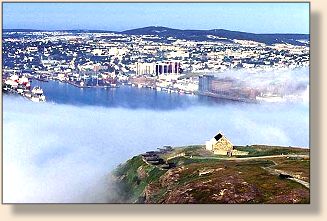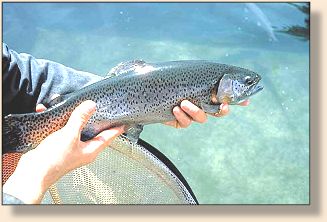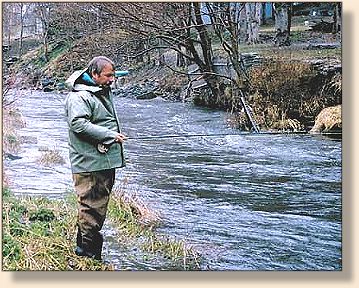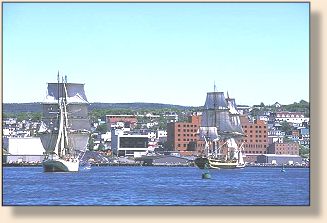The Downtown Fly Fisher
Fly Fishing North America's Oldest City - St. John's Newfoundland

Text and Photos By Paul Smith and Ian Gall
The Europeans who first began to visit Newfoundland in the sixteenth
century came for the fishing. The city of St. John's, which was established
by Sir Humphrey Gilbert in 1583 (making it North America's oldest city),
served as a supply base for fishing fleets from England and other European
countries, which all competed for control of the fisheries. Consequently, for
the next 200 years St. John's was a prime military target for the competing
nations, until the English established permanent control in 1772.
Today, the saltwater fishery is only a faint shadow of what it used to be and
the conflict has largely shifted from a struggle between nations competing for
control, to a campaign to preserve and sustain wild stocks of fish in both
salt and fresh water.

Fortunately, despite the universal decline of wild Atlantic salmon, many
Newfoundland rivers still enjoy relatively respectable runs. The three rivers
which flow through St. John's - the Waterford, the Rennie's, and the Virginia
lost their salmon runs years ago. However, a stocking program to reintroduce
Atlantic salmon in all three rivers started several years ago. In 1999, six grilse
returned to the Rennie's . There have been reports of salmon entering the
Waterford River, but they were never confirmed. In 2000, only one grilse
returned to the Rennie's River, but local flyfishers remain hopeful. Salmon
parr are still caught occasionally, and it is hoped that, through time, a viable
run will be established again. The stocking program utilizes personnel from
all stakeholder organizations, including The Salmonid Association of Eastern
Newfoundland and the Federal Department of Fisheries.
Nevertheless, despite the lack of salmon, St. John's three rivers offer superb
flyfishing for resident and anadromous brown trout. In addition, there is also
excellent fishing in a number of lakes (known locally as "ponds"), all within
the city limits.
The Rivers
The Waterford River flows directly into St.John's harbor, while the other two rivers
flow into Quidi Vidi Lake and, finally, into the sea at the tiny fishing village of Quidi
Vidi on the east side of the city. All three are blessed with healthy populations of
brown trout. In addition, brook trout can be found in small numbers, especially
in the smaller feeder streams.

The browns are descendants of fish brought over in the 1880's from England, Germany
and Scotland. Locally, the fish are often called "German Browns," but the characteristics
of most fish seem to be of the Scottish "Loch Leven" strain. The fish were first established
at Murray's Pond, which was and still is a private fishing club. They were also released
into several small streams and gradually migrated into salt water.

Today, sea-run browns are found all around the Avalon Peninsula, where they flourish,
making Newfoundland a world-class flyfishing destination. (For a more detailed
treatment of sea-run browns in Newfoundland, see the Summer 2000 issue of The
Canadian Fly Fisher.) Lower Pond, Witless Bay, a mere 20 minutes from St. John's,
has produced several fish in the 20 pound range. The largest sea trout caught during
the year 2000 was a hefty 25.5 pounds - bigger than the largest salmon taken by most
fly fishers - and a trophy in anyone's book.
In the city rivers, the browns run somewhat smaller, with sea-run fish up to 5
pounds being taken. But, despite their relatively smaller size, they make up for
it in sheer numbers - these rivers teem with trout. While spring and late fall
offer the best chance of trophy catch, the trout season starts in early February
and continues until October with a closure of one month from mid-April to
mid-May - measure to help protect and enhance the wild native brook trout
fishery. However, fishing for brown trout remains open on a number of rivers,
with a strict mandatory release policy for any incidentally hooked brook trout.
In the city of St. John's during the closure period, the lower reaches of the
Waterford and a section from the outlet of Quidi Vidi Lake to the sea remain
open for fishing for sea run browns. The mandatory release policy for native
brook trout applies.
The Waterford River
Due to its dense trout population, ease of access and proximity to the business
quarters, the Waterford River is the visitor's best bet for some downtown fishing.
A good place to begin is at the Chalet that marks the beginning of the eastern
terminus of the Trans-Canada Trail. Moving upstream, you'll find the first few
hundred yards is composed of several small falls and pocket water. In early spring,
this is an ideal stretch for dead drifting large nymphs, such as the Montana or Zug
Bug. Streamers such as the Muddler Minnow, Black Ghost, and an Alevin pattern
also work well, fished down and across. Bead head nymphs are very productive,
as fresh-run sea trout seem to have a particular liking for them, either dead drifted
or fished down and across. My own favourite nymph is a no-name brand creation
tied primarily with peacock olive chenille. In the mid-summer months, a small White
Wulff or a Deer Hair Bug is ideal for dry fly fishing the broken pocket water behind
the rocks and small falls.

The middle stretch of the Waterford (about 1.5 km of flat flood plain) is composed
mainly of riffles, a few deep runs, and several large pools. This section is most
productive in summer when the high grass along the riverbank provides shade
and cover for resting and feeding trout. The best approach is to wade upstream
armed with midge and small dry fly patterns (sizes 14 to 18). A local favourite
consists of a black body, with two or three strands of brown deer hair tied in as
a back sloping wing (cut very short) and with a sparse black hackle (one or two
turns) wound in front of the wing. Standard patterns that work well are small
Adams (parachute or otherwise), and small CDC emerger. Experimentation will
usually pay off, as the fish are not overly selective. At the upper end of the
middle section there is a larger falls with very broken water below it. This is
another great opportunity for nymph fishing. Dead drifting with standard nymphs
and bead heads should produce results.
The upper section of the river begins above the falls and continues up to another
falls located at Bowring Park. Here the river splits into two branches. Fishing is
prohibited within the park, but above it, the fishing in both branches, while not
as popular as downstream from the park, is still quite good. In autumn, a large
falls on the North branch of the river provides a great display of leaping trout
on their spawning run. ~ Paul and Ian
Continued next time!
|

